#1920's Broadway
Explore tagged Tumblr posts
Text
Time Travel Question 73: Assorted Performances XII
These Questions are the result of suggestions from the previous iteration.
Please add new suggestions below if you have them for future consideration.
This is the last of the already prepped Performances polls left. Have more suggestions? Feel free to weigh in.
Unless there is a landslide of suggestions, we'll be going back to the 20th century and earlier soon. I do have some music polls I want to run in February, which will effect the posting schedule.
#Time Travel#Concerts#Performances#Theater History#Broadway cast#Into the Woods#Ralph Fiennes#Hamlet#Shakespeare#The Phantom of the Opera#1925#Silent Film#Freaks 1932#Pre-Code Cinema#The Cabinet of Dr. Caligari#German Expressionist Cinema#King Kong 1930#Old Hollywood#Classic Hollywood#The Black Cat 1934#Abbott and Costello Meet Frankenstein 1948#Abbott and Costello#Frankenstein#Universal Monsters#1930's#1940's#1920's#Davy Jones#the Artful Dodger#Oliver
60 notes
·
View notes
Text


Illustrated “Poster Views of New York” from 1924 by artist A. Broun. Most postcards were raw photos or photos traced over and colored by illustrators, making these unique in the postcard landscape. The first of times square is particularly striking with the balls of light clustered above the avenues and real signs drawn from memory, introducing a spelling error in “Ziegfeld.”
#history#nyc history#new york city#nyc#vintage nyc#1920s#roaring twenties#architecture#vintage art#postcards aesthetic#vintage postcards#postcards#times square#broadway#ulysses s grant#riverside drive#voca1ion
6 notes
·
View notes
Text
Still technically on the break, but I had so much fun writing this chapter that I just had to pop in and share:
https://archiveofourown.org/works/60075286/chapters/164908462
The two of them locked eyes, and the woman sauntered over to Sofie, and reached out a lax hand. “Hello,” she said – her voice was dark and drawling, her Southern accent thick, “I’m a lesbian, what do you do? Or should I ask who?” Sofie instantly turned red. “Tallulah!” Another woman next to her objected in a nasal tune that betrayed her New York origin. “You really gotta stop introducing yourself that way. If you’re off chasing Napier across the danged Atlantic, you simply can't say you're still a lesbian!” Tallulah turned around and positively shot daggers in the other woman’s direction. “I am not chasing after Naps,” she clarified. “I am testing my fortune at the West End. Bloody ol’ England won’t know what hit ‘em!” “Regardless, with the amount of men you’ve bedded by now, you’ve lost the right to call yourself a lesbian anymore,” the woman objected. “And who are you Maria, the word police? Fine, we can’t all be exclusively sapphic like you,” she shrugged, and faced Sofie again. “I’m ambisextruous, how about you?” Sofie turned a darker shade of red, and looked over her shoulder. “Also not a word,” Maria objected. “Says who?” Tallulah complained. “The dictionary,” Maria quipped.
Tallulah Bankhead is such an inspiration.
#ao3#fanfiction#tarzan#writing#fanfic#edgar rice burroughs#the adorable idiots the Tenningtons#Tallulah Bankhead#the roaring 20s#1920's#theatre#Broadways star#the West End
2 notes
·
View notes
Text

#the marx brothers#marx brothers#marx bros#groucho marx#chico Marx#harpo marx#zeppo marx#gummo marx#the cocoanuts#broadway#broadway musicals#broadway musical#vintage broadway#musicals#musical theatre#musical theater#george s. kaufman#irving berlin#1920s
3 notes
·
View notes
Text
Hello!
We're noticing more people being interested in the Raggedy Ann fandom since the Amazing Digital Circus pilot released, so we thought we'd update our masterpost on where to find more Raggedy Ann media!


Books:
The first two and most well-known books are Raggedy Ann stories (1918) and Raggedy Andy stories (1920), which are in public domain and free to read online! Camel with the Wrinkled Knees (1924) (which the movie was loosely based on!) is on Internet Archive and available to read without an account. You can find many of the other books on there as well.
Cartoons:
The 1940's has Raggedy Ann and Raggedy Andy (1941), Suddenly It's Spring (1944), and The Enchanted Square (1947).
You've got the 1977 Raggedy Ann & Andy: A Musical Adventure of course.
The Chuck Jones holiday TV specials: Raggedy Ann and Andy in The Great Santa Claus Caper (1978) and Raggedy Ann and Andy in The Pumpkin Who Couldn't Smile (1979).
Most episodes of The Adventures of Raggedy Ann and Andy (1988-1990) are in this playlist here, and you could probably find any missing ones on Dailymotion.
From the Target crossover we have the animated Snowden: Raggedy Ann & Andy's Adventure (1998) and the live-action ice-skating special The Snowden, Raggedy Ann and Andy Holiday Show (1998).
Music:
I've also got a playlist of all the albums I've found on YouTube or were uploaded by us, and there's many more of the older ones available on Archive. The old Will Wooden and Frank Luther ones are very charming.
Musical:
You can watch recovered archival footage of the full first production of the Raggedy Ann musical (1984), listen to the demo album (~1985), or the Broadway bootleg (1986)!
If you're interested in more, I'd recommend exploring the saved playlists on the RARE YouTube channel or the media tag on the Raggedy Ann Fandom Wiki.
We're a group of Raggedy Ann enthusiasts who got together to search for Raggedy Ann lost media (specifically the musical), but now we collect and archive all sorts of things from the franchise! Our ask box is always open and we love to find things people are looking for, or even just chat about headcanons and such.
-Mod General D.
#raggedy ann#raggedy andy#mod general d#raggedy ann and andy#raggedy ann and andy musical adventure#raggedy ann and andy a musical adventure#raggedy ann revival effort#raggedy ann musical#rag dolly#raggedy ann broadway#rag dolly musical
726 notes
·
View notes
Text
Symbols that are associated with gay history - Violets

Violets were often referenced in the ancient Greek poet Sappho's poems, which were very gay. In the 1920's, in the Broadway play The Captive, the female protagonist is gifted violets by her female lover, which ended up getting the play banned in New York. Queer women in Paris protested this by wearing violets to playing's of the play. After that many women gave other women violets as a romantic gesture.
Source: History of Queer Women's Symbols by STRANGEONS on Youtube
Picture drawn by me (tiredb1s3xual)
#art#lgbtqia#queer#asexual#bisexaul#aroace#acespec#aromantic#history#queer history#lgbt history#gay history#sappho#sapphics#violets#flowers#tiredb1s3xual art
82 notes
·
View notes
Text

1927 Percy Verwayne as the original "Sporting Life" in Broadway's first run of "Porgy". From America in the 1920's, FB.
95 notes
·
View notes
Text
Ok I've had enough of this "Alastor doesn't know about gay stuff" I keep seeing around. As a history nerd I honestly can't take it anymore.
Kiddos it's time to learn you a few things. First of all, compared to subsequent decades,
The 1920s were incredibly gay
Was it still illegal to perform homosexual acts, yes. Were gay people still abused and lost jobs for being gay, and were even socially excluded from cishet white society? Oh absolutely. Did most individuals have to stay closeted? Duh. But you know what wasn't a wide spread thing yet? The medicalization of homosexuality. Conversion therapy wasn't fully approved of by psychiatrists until the 40's. Crossdressing wasn't considered mental illness, scandalous, yes, but not mental illness. The haze codes were not implemented yet, and the combination of prohibition, the two decades prior of progressivism, and the horrors of world war one left the youngest generation with a rebellious spirit and a desire for breaking the law. And if you lived in a big city, being LGBT in the twenties was often better than being LGBT in the 30s, 40s, or even 50s.
Young rich kids would seek out queer cruising spots in cities as a form of tourism. Harlem was famous for it's yearly drag balls, and many of the most famous black artists at the time were infact lgbt. Broadway and Hollywood were full of individuals who people knew were not entirely straight. Hell, jazz was born in red light districts home to black queer people. In places like New York there were people famous for being openly gay and despite sodomy laws police would not care in the slightest about them.
And though the South was as fucked as it ever was with Jim Crow Laws and the race riots, New Orleans has always been one of the more progressive cities in the South and has always had a very large gay community. Between the inherit campiness and debauchery of Mardi gras to being the birth place of jazz, to new Orleans being the easiest place to get away with breaking prohibition laws in the south, Alastor as a mixed race black radio host playing jazz in New Orleans in the 20s ABSOLUTELY is familiar with the LGBT community of the time.
The thing is, the language used by the community at the time was so fundamentally different that alastor would not know what you are talking about if you spoke to him about modern LGBT issues. The pride flag did not even exist yet. Gay still meant happy to him in his age. "Bisexual" at the time was more akin to the term "trans" than being attracted to multiple genders, and transgender didn't exist yet as a word. But if you called yourself "a confirmed bachelor" he would understand you were a man who liked men. If you called yourself a "fairy" he would know you weren't cis. If you were a woman and told him you liked sapho or Peter pan, he'd know you liked women. And if you were wearing lavender, or a green carnation, a red bowtie, a violet (if you were a woman), or were a man with a peacock feather in your ensemble he would give you a knowing nod. He's not ignorant of the lgbtq. He's a man out of his time. He speaks a different language entirely to modern gay slang, so it seem he doesn't know anything about it. But he does. Gay and trans people have always been a thing and as a radio host, literally being on the forefront of mass media at it's beginnings, in arguably the best decade to be gay in the 20th century before the 60s, in a city so comfortable with what was considered debauchery that it gave birth to "devil music" and embraced it before anyone else, yes he knows what they are. He just doesn't have the modern language to express it.
#alastor hazbin hotel#1920s#lgbt history#rant#hazbin hotel#he would be confused as hell if you asked him where to find a gay bar to pick up twinks#but you ask him to take you to a saloon where all the fit young sailors hang out and he could instantly give you directions
63 notes
·
View notes
Text


Alan McNaughton, the Scottish actor was born March 4th, 1920 in Bearsden.
He was educated at The Glasgow Academy, trained at RADA, and graduated in 1940 with the Bancroft Gold Medal
A very talented , but underrated actor, most of his work was in the theatre playing at The Old Vic and on Broadway, he also appeared on TV playing barristers, public servants, scientists and officers, he played four different parts in Dr. Finlay’s Casebook, over it’s original run of 5 years in the 60′s.
He also appeared in shows like The Sandbaggers; To Serve Them All My Days and A Very British Coup, as well as Kavanagh QC, Soldier, Soldier and an episode of Hamish Macbeth
He died of cancer on 29th August 2002, aged 82.
7 notes
·
View notes
Text
Jester Hairston
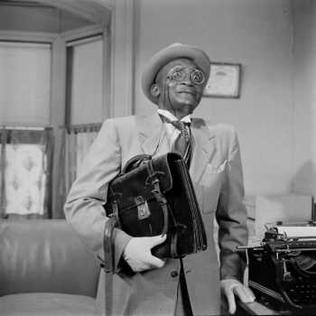
By Life Magazine via Google Images-Photographer Loomis Dean., Fair use, https://en.wikipedia.org/w/index.php?curid=28896923
Jester Joseph Hairston (July 9, 1901 – January 18, 2000) was an American composer, songwriter, arranger, choral conductor and actor. He was regarded as a leading expert on black spirituals and choral music. His notable compositions include "Amen," a gospel-tinged theme from the film Lilies of the Field and a 1964 hit for the Impressions, and the Christmas song "Mary's Boy Child."
Hairston was born in Belews Creek, a rural community on the border of Stokes, Forsyth, Rockingham and Guilford counties in North Carolina. His grandparents had been slaves. At an early age, he and his family moved to Homestead, Pennsylvania, just outside Pittsburgh, where he graduated from high school in 1921. Hairston was very young when his father was killed in a job-related accident. Hairston was raised by his grandmother while his mother worked. Hairston heard his grandmother and her friends talking and singing about plantation life and became determined to preserve this history through music.
Hairston initially majored in landscape architecture at Massachusetts Agricultural College in the 1920s. He became involved in various church choirs and choral groups, and accompanist Anna Laura Kidder saw his potential and became his benefactor. Kidder offered Hairston financial assistance to study music at Tufts University. from which he graduated in 1929. He was one of the first black students admitted to Tufts. Later he studied music at the Juilliard School.
Hairston pledged the Chi chapter of the Kappa Alpha Psi fraternity in 1925. He worked as a choir conductor in the early stages of his career. His work with choirs on Broadway eventually led to singing and acting parts in plays, films, radio programs and television shows.
Hairston sang with the Hall Johnson Choir in Harlem for a time but was nearly fired from the all-black choir because he had difficulty with the rural dialects that were used in some of the songs. He had to shed his Boston accent and relearn the country speech of his parents and grandparents. Johnson had told him: "We're singing ain't and cain't and you're singing shahn't and cahn't and they don't mix in a spiritual." The choir performed in many Broadway shows, including The Green Pastures. In 1936, the choir was asked to visit Hollywood to sing for the film The Green Pastures. Russian composer Dimitri Tiomkin heard Hairston and invited him to what would become a 30-year collaboration in which Hairston arranged and collected music for films. In 1939, Hairston married Margaret Swanigan. He wrote and arranged spirituals for Hollywood films as well as for high school and college choirs around the country.
Hairston wrote the song "Mary's Boy Child" in 1956. He also arranged the song "Amen", which he dubbed for the Sidney Poitier film Lilies of the Field, and arranged traditional Negro spirituals.[16] Most of Hairston's film work was in the field of composing, arranging and choral conducting. He also acted in more than 20 films, mostly in small roles, some uncredited. Hairston starred in John Wayne's The Alamo (1960), in which he portrayed "Jethro," a slave owned by Jim Bowie. In 1962’s To Kill a Mockingbird Hairston portrayed the uncredited role of the father of accused rapist Tom Robinson. In 1967’s In the Heat of the Night, Hairston portrayed the butler of a wealthy racist being investigated for murder. In both films, Hairston shot scenes along side men who won an Academy Award for Best Actor in those respective films for portraying white Southerners navigating their jobs through a racially divided culture.
In 1961, the U.S. State Department appointed Hairston as Goodwill Ambassador. He traveled all over the world teaching and performing the folk music of the slaves. In the 1960s, he held choral festivals with public high-school choirs, introducing them to Negro spiritual music, and sometimes led several hundred students in community performances. His banter about the history of the songs along with his engaging personality and sense of humor endeared him to many students.
During his nationwide travels, Hairston checked local phone books for other Hairstons and reunited many people on his family tree, both black and white. He composed more than 300 spirituals. He was the recipient of many honorary doctorates, including a doctorate from the University of Massachusetts in 1972 and a doctorate in music from Tufts in 1977.
In his later years, Hairston served as a cultural ambassador for American music, traveling to numerous countries with choral groups that he had assembled. In 1985, he took the Jester Hairston Chorale, a multiracial group, to sing in China at a time when foreign visitors would rarely appear there.
Hairston died in Los Angeles of natural causes in 2000 at age 98. For his contribution to the television industry, Hairston has a star on the Hollywood Walk of Fame located at 6201 Hollywood Boulevard. He is interred at Inglewood Park Cemetery, Inglewood, California.
33 notes
·
View notes
Text
Time Travel Question 74: Assorted Performances XIII
These Questions are the result of suggestions from the previous iteration.
Please add new suggestions below if you have them for future consideration.
#Time Travel#Concerts#20th Century#Performances#Lady Be Good#Fred Astaire#Adele Astaire#West End#1926#Theatre History#Theater History#The Lady's Not for Burning#1948#Christopher Fry#The Takarazuka Revue#1910's#History of drag#Japanese history#Women in History#Alan Rickman#Les Liaisons Dangereuses.#One Week 1920#Buster Keaton#Silent Film#Stephen Sondheim#Aristophanes#Musicals#Broadway#The Frogs#Movie History
72 notes
·
View notes
Text




Views of Rainbo Gardens at Clark Street and Lawrence Avenue in the 1920's. Outdoor entertainment venues were to be found all over the northside. The Green Mill was a short stumble down Lawrence, The Bismarck Gardens further south at Broadway and Grace. More info on Rainbo's long history here
6 notes
·
View notes
Text
The Riviera Theater, Uptown, Chicago
4746 N Racine Ave, Chicago, IL 60640
Opened Oct. 2, 1918
C.W. Rapp and George Rapp, architects
Balaban & Katz, original owners
Seating Capacity: 2,500
Jam Productions, current owners
Current use: Concert venue
Completed in 1917 by architects George and C.W. Rapp (Rapp & Rapp), it was built as a movie theater for the Balaban & Katz chain. Transformed into a private nightclub in 1986, the Riviera Theatre is now one of Chicago’s premier concert and special events venues.
Jam Productions website https://www.jamusa.com/venues/riviera-theatre

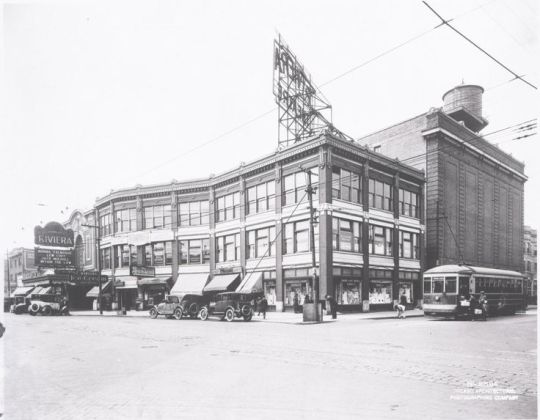
Broadway and Lawrence, Uptown


Two theaters: the Riviera and the Uptown
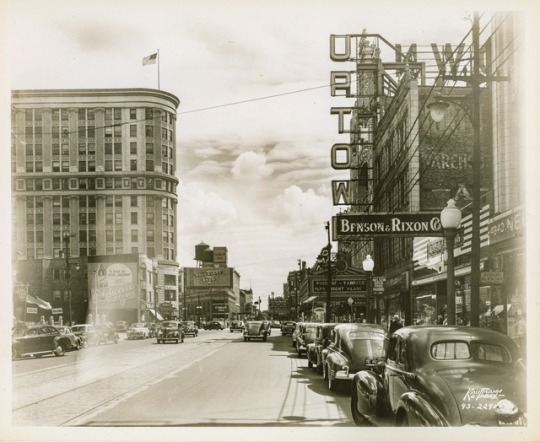

Photo on display in the Riviera lobby, showing original chandelier, now gone, and the box office, which remains

The Riviera Theatre was the largest and most ornate of the movie theatres of the Uptown neighborhood until the opening of the Uptown Theatre almost a decade later. Opened October 2, 1918 with Lina Cavalieri in “A Woman of Impulse”. Built at a cost of well over half a million dollars (delayed by almost two years due to World War I), this Rapp & Rapp-designed house located on N. Racine Avenue between Broadway and W. Lawrence Avenue, originally seated 2,600 and its building also featured eight storefronts and over 30 apartments. Initially the Riviera Theatre was to have been operated by the Jones, Linick & Schaefer chain, which operated several Loop movie houses in the 1910’s and 1920’s such as the Orpheum Theatre, the Rialto Theatre, and the McVickers Theatre. However, the Riviera Theatre ended up becoming the second major theatre of the Balaban & Katz circuit, which at the time also included the Central Park Theatre, now regarded as Chicago’s first true ‘movie palace’. Featuring movies accompanied by the orchestra of S. Leopold Kohl, the Riviera Theatre also featured “high class” musical acts on stage. It was initially equipped with a Barton theatre organ which was later replaced by a Wurlitzer organ. The theatre mainly catered to the upper-middle class residents of the Uptown area, especially women. The Riviera Theatre continued to remain one of the neighborhood’s most popular movie houses for decades, even once the almost 4,500-seat Uptown Theatre opened just down the street. By 1977 it was in its final days as a full-time movie theatre as occasional live concerts were beginning to be staged. It became first a nightclub in 1986, and a few years later, after the nightclub closed, one of Chicago’s most popular concert venues, as it remains today. It still has a feel of faded elegance to it, and in 2000 the concert hall was named one of the historically important structures making up the Uptown Square National Historic District.
www.cinematreasures.org
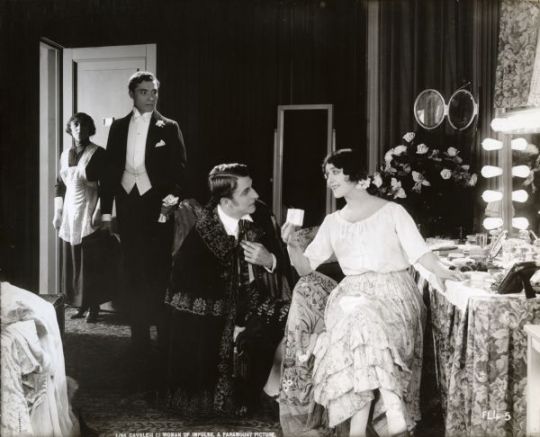
In a scene still from the American drama film A Woman of Impulse (1918), Leonora, the opera singer known as "La Vecci" (played by Lina Cavalieri) sits in her backstage dressing room receiving visitors.
The Riviera Theater was open to the public on the weekend of October 14-15, as part of the Open House Chicago weekend sponsored by the Chicago Architecture Foundation. It was my first time inside the theater.
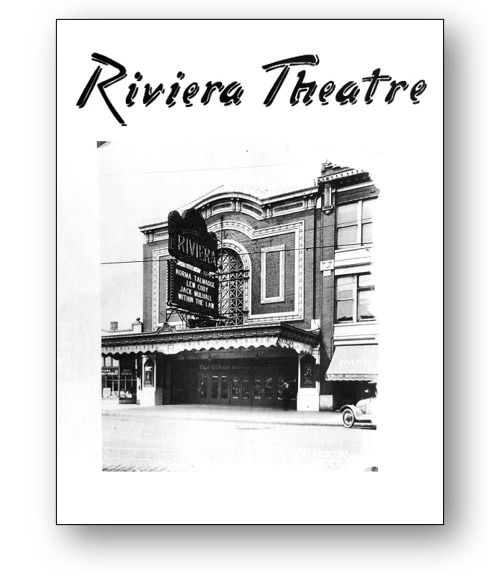
Jam Productions thoughtfully provided a booklet with a history of the Riviera and reproductions of archival photos. A couple of the images are scanned below.
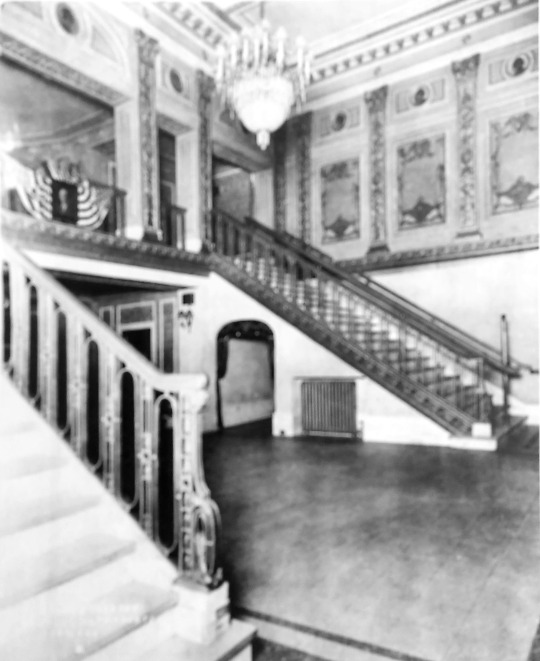
Theater lobby
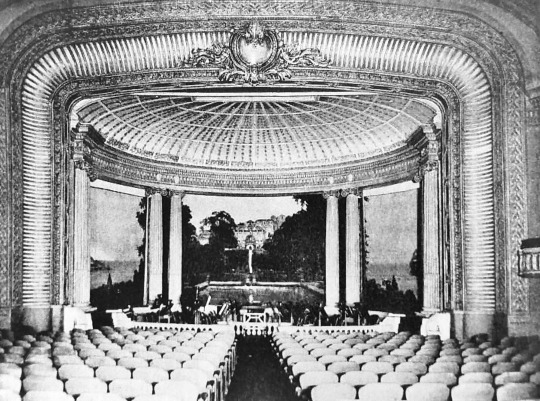
Such stage sets were often inserted for the performance of "prologues" or musical numbers before the movie screen would be lowered for the film showing.
As usual, interior photography is difficult without a tripod, and though some of these images are blurry, they give a good impression of what remains a stunning interior.
Sometimes thought of as a "companion" to the much larger Uptown theater just across Lawrence on Broadway, the Riviera was built first, and inspired the slightly later Chicago Theater in the Loop.
The purple wall color is not original, but there are no current plans to change it to the muted tones of the original scheme. A couple of original stencil designs have been uncovered in the lobbies, which will eventually be reproduced. The murals in the auditorium are faded and covered by grime and nicotine, but being backed by heavy paper rather than canvas, their restoration will prove tricky, and there is no current timeline for this process.
I was a bit mystified by the lack of theater seats on the main floor, which resembles a large concrete-floored nightclub rather than a theater. Never having been to a concert in this venue, I imagined what a standing-room crowd would experience here. the balcony level, however, has recently-installed theater seats, and seems a comfortable place from which to enjoy music.
The lobby features one of the original chandeliers from the Granada Theater in Rogers Park; somewhere there is a companion piece, which Jam hopes to acquire eventually for the outer lobby. The huge light fixture isn't exactly elegant; seen from the upper lobby, its design seems rather awkward. That, in my opinion, is one of the weaknesses of early movie palaces, which strove for an overall "wow" effect rather than architectural refinement or historical accuracy of detail.
Here are my photographs from my visit to the theater on October 14:
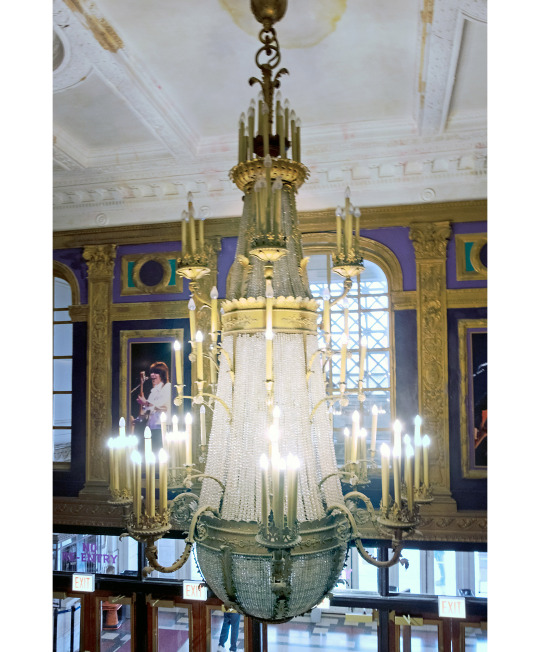
The Granada chandelier in the Riviera lobby
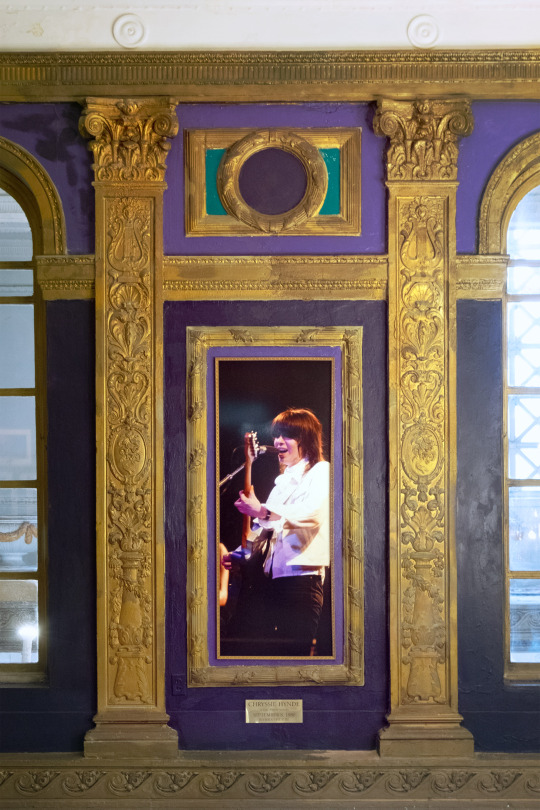
That's Chrissie Hynde
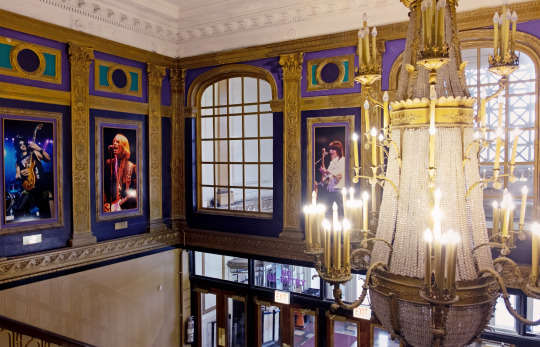





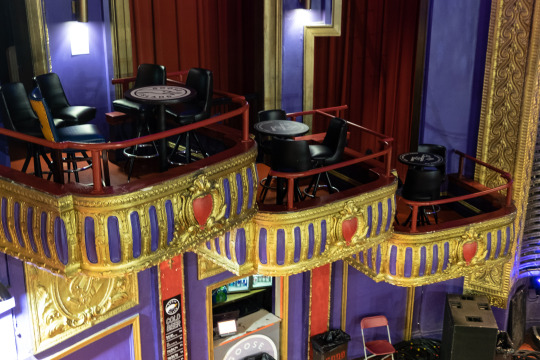
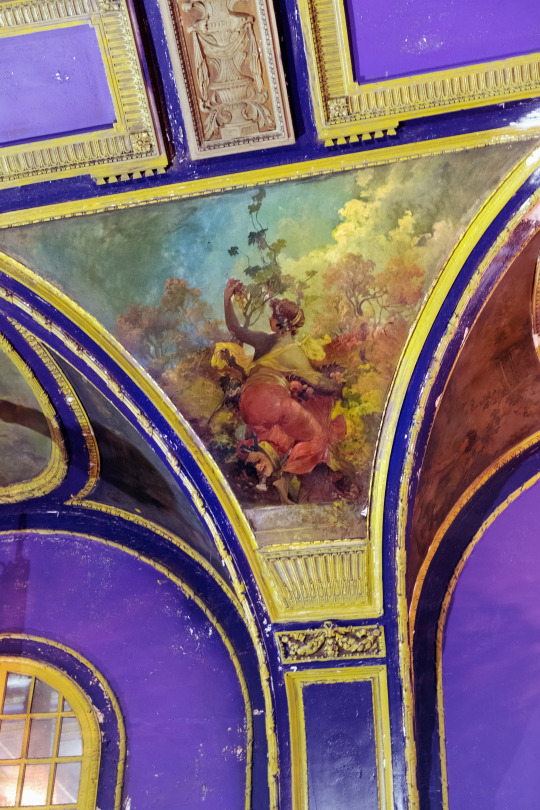
One of the depictions of the four seasons in the auditorium. The painting isn't nearly this clear or colorful; it's been Photoshopped. It appears muddy as in the next photo.
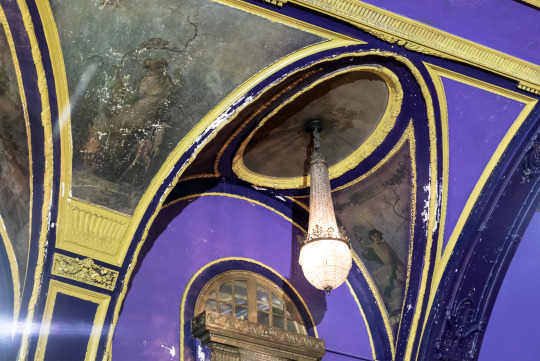
The six side light fixtures were later additions, and were simply hung from the center of the oval paintings.

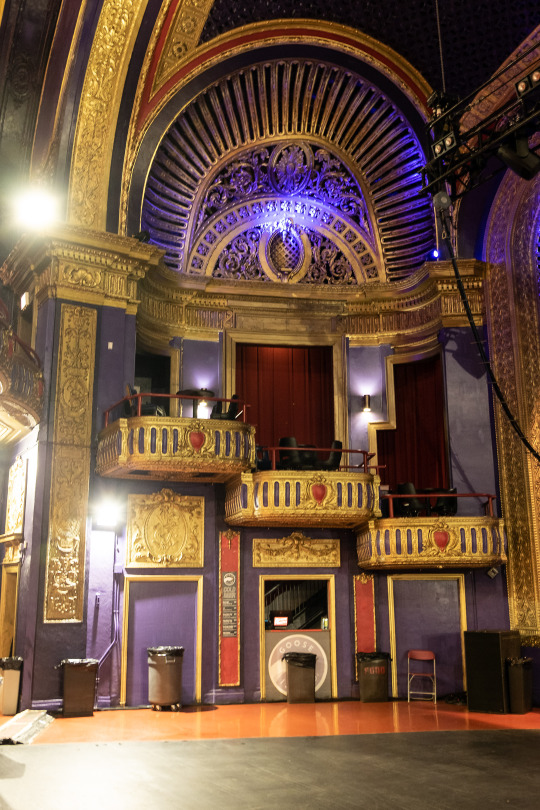
#Chicago#architecture#movie theater#cinema#movie palace#Riviera Theater#Uptown#Open House Chicago#Rapp and Rapp#Balaban and Katz#Jam Productions
46 notes
·
View notes
Text
James Abbe photo of the popular 1920’s vocal trio, the Brox Sisters. Not sure whether the horns are props or not, but they generally just sang. After success on Broadway, including the original stage production of the Marx Brothers’ “Cocoanuts”, they appeared in early film musicals. They have been referred to as forerunners of the Boswell Sisters, Andrews Sisters, and other popular female trios of the 1930’s/40’s and beyond.

2 notes
·
View notes
Text
You guys really liked the "Ecclectic Halloween" post I did a while ago, so I want to go for another round!!
For those who didn't see the previous post - music is my biggest hyperfixation, and I love making thematic playlists and play with them by adding little rules and such. My "Ecclectic Halloween" playlist currently has over 150 tracks, and all of them are there according to the following little rules I've stablished:
The song MUST include anything supernatural, spooky, bizarre, "murder/serial killer", classic creature and so on - if it's instrumental, which is the case of many tracks in this list, it has to have all of these but in VibesTM
The song can be of ANY genre; is it metal? Prog? Disco? Electronic? Soundtrack? COOL, ALL ARE WELCOME!
I'm still including less widely known / "cliche Halloween songs", and this time I decided to feature songs that are soundtracks (from movies, games, animes, books even!); most of them are instrumental, or feature a heavy use of choir, and/or vocals that are prevalent but doesn't really mean anything (bear with me, you'll see what I mean, lol)
LET'S GET STARTED, part deux!!
1- Only Murders In The Building - Creatures of the Night
youtube
Starting off with this banger from the latest season of "Only Murders in the Building"! The original context is that Oliver Putnam, one of the main characters who's a theater producer/director, decides to put on a musical play as one of the main subplots of this season; the show actually presented a couple of full, real songs, and they are all REALLY Broadway-like, campy, and epic (fucking Meryl Streep sings two of them???? It's REALLY good!). The musical's plot is that this woman was murdered in a mysterious lighthouse, and a private Investigator and a Constable comes in to investigate it. The main suspects are the Nanny and... the baby triplets of the deceased woman??? Lol This song is SUPER fun, weird and extra, with that little touch of mystery - it's the "opening act" of the show, and it's the Investigator arriving at the lighthouse, singing with the whole ensemble cast, it's SO cool! I'm including here the actual scene where they perform it, so you can see it! (Spoilers for the last episode of s3, I guess?)
In this eerie old lighthousе thrashed by the tide Live triplets whose mother suspiciously died And suspects uncanny, a constable, a nanny Do they all have secrets to hide?
2- Genshin Impact - Die Mittsommernacht-Fantasie
youtube
This one is VERY "mischievous trick or treat" vibes! Very, very fun and colorful, with that little touch of mystery, too! This was definitely one of the best battle themes in Genshin Impact, and it was featured exclusively in a time-limited event last year?? Such a tragedy this good of a song was used only then!
The domain this song appears is themed after the character Amy "Fischl", who roleplays all the time as "Fischl, the Prinzessin der Verteilung"; the domain itself was a huge castle, with big fairytale vibes going on. Fischl is a very dramatic, mischievous character, and this theme really reflects that, in the most fun way! The song has INTENSE baroque influences with the harpsichord as main instrument, and even features a classic/ spanish guitar!
3- Cuphead, The Delicious Last Course - The Finishing Touch
youtube
To those unfamiliar, Cuphead is a game that mimics the entire aesthetics, artstyle and music from 1920's cartoons. It's honestly one of the best ideas I've seen, and this one is a song from the DLC released a while ago. It's very spooky, and of course in that 20s cartoon sort of way.
I personally love the super eerie atmosphere, the flute, piano and the strings combo creating all the tension!
4- Young Sherlock Holmes - The Ceremony / Waxing of Elizabeth ("Rametep Theme")
youtube
These are technically two songs, but some good soul mashed them together into one cohesive piece, because they both really, REALLY slap hard with the dramatic chorus and Carmina Burana-esque energy! This was featured in the movie "Young Sherlock Holmes", in a scene where a crazy-ass cult is having their gathering, and preparing to mummify this girl.
I have to say the soundtrack is actually better than the scene itself, lol. It has a really impressive crescendo and use of orchestral metals, I have goosebumps every time I listen to it, hnnng <3
5- Ori and the Will of the Wisps - Mora, the Spider
youtube
Easily one of the most intense boss fights I've ever played - and the theme really reflects that fear and tension. Mora is a giant spider hidden in the deep, buried shadows of the forest that you, as Ori (a light/forest spirit) has to defeat. It really is a "dark vs light" sort of fight, and the this theme really goes fucking hard. It also has strong horror music elements used in movies of the genre - like the violin pizzicato at the beginning, and its use throughout the piece, giving that "classic horror" feeling to it.
Note how when the choir kicks in around the minute 2:15 - they are chanting "MO-RA! MO-RA!" in such a terrifying way! And then, around 4:50, it really shows how Ori's determination and hope prevails, when their leitmotif starts playing!
6- Yuki Kajiura - Ship of Fools
youtube
If you follow me for a while, you know already that Yuki is literally one of my all-time favorite composers ever, so OF COURSE I had to include her here!! She is an OST composer for animes and games, and this was the first song of her I've ever heard - it plays on the very first scene of the "Tsubasa Reservoir Chronicles" anime. Yuki is well-known for her dreamy, haunting style and this piece is a huge example of it!
She mixes in electronic, rock/metal, classic and folk genres, and layered vocals (mostly done by singers hired for her projects). This one is also an example of her using the "kajiurago", or "kajiura language" - it doesn't mean anything, it's just vocalizing that sounds like words. They are one of her trademarks, and one of her elements that really gives the etheral, haunting atmosphere in her works!
This song really goes hard into the "mysterious, dangerous witch" territory, and I fucking love it! <3
7- Yuki Kajiura - The Main Theme of Petit Cossette
youtube
Another one from my favorite girl - this one is soundtrack to a very obscure anime called "Le Portrait de Petit Cossette" - it's essentially the story of a girl's ghost (Cossette) trapped in an artifact (I think it's a goblet?? It's been over 15 years since I saw it, lol), and this guy who falls in love with her. It's a very weird, dark and atmospheric animation.
This one track here really translates that energy, and I honestly HIGHLY recommend the rest of this OST - it's VERY VERY GOOD, and mostly all tracks have that dark, eerie, gothic vibe too.
Here we can see once more the use of "kajiurago", and another trait of Yuki's work that I fucking love - the intricate solos!! In this case, a violin solo, which is also very prevalent in most of her work.
8- Mary Fahl - Exiles (The Wolves of Midwinter)
youtube
Another Anne Rice-inspired! "Exiles" was composed by Mary Fahl as an actual official song for the audiobook version of "The Wolves of Midwinter". I don't know about the book's plot because I haven't read it, but this song is SO atmospheric, and it's very werewolf-y. I personally LOVE Mary's deep voice, and how I can almost see the wolves running in the wintery forest.
When the hunger comes and I lose control Hold me in the darkness, bless my tarnished soul I will run beside you, we'll leave the past behind We'll hide inside the ages beneath the sands of time
9- Karliene - Become the Beast
youtube
Technically, the only one of the playlist that isn't a soundtrack - not offcially, anyway, hehe. This is a song that Karliene wrote inspired by Hannibal, the tv show; I haven't seen Hannibal, but I'm OBSESSED about this one, because yeah, it can be about Hannibal, but I like how she's a bit vague about it, so it can also be about werewolves, or any other dark supernatural creature, like vampires.
Her voice is incredible, and I love how "minimalistic" this song is, featuring pretty much only a violin, piano and cello as insstruments. The pizzicato sound comes in again to give that unsettling, classic horror vibe, at the same time her layered vocals + the piano and cello really softens the whole thing, which in my opinion, makes the song so eerie and menacing - even more with the lyrics!
So look in the mirror and tell me, who do you see? Is it still you? Or is it me? Become the beast, we don't have to hide Do I terrify you or do you feel alive? Do you feel the hunger? Does it howl inside? Does it terrify you? Or do you feel alive?
10- Wolfwalkers - Howls the Wolf (Moll's Song - Wolf Run Free)
youtube
And closing the "werewolf trilogy" here at the end of the playlist with another favorite of mine - and ending with wholesome vibes! This is a song that plays in the credits of the animated movie "Wolfwalkers" - IF YOU HAVEN'T SEEN THAT MOVIE YET, AND YOU LOVE ANIMATION, YOU MUST. LIKE FOR REAL. ITS SO GOOD. And the entire soundtrack, written by Kíla and Bruno Coulais, fucking slaps - it's mostly all traditional folk Irish music and instruments, and so full of life!
Wolfwalkers here are people who turn into wolves when they fall asleep - their sleeping body remains behind, as their soul takes a tangible form of a wolf. It's pretty rad!!
And this song, it's Moll, the wolfwalker mother, probably singing this "lullaby" to her daughter, the wolfwalker Mébh (and one of the main protagonists, the red haired little girl in the art above!).
Maria Doyle Kennedy is the one voicing Moll and singing this song, she has such a pretty, soothing voice! I love this song so much, and with the context of the movie, it makes me teary-eyed almost every time I listen to it kjdfhkjdf, ahhhh <3
The wolf will leap from child asleep The wolf will run 'til rising sun The wolf will guide you in your dreams Run free! Wolf, wolf, howls the wolf Wolf, wolf, run free!
Hope you also like this second part!! And it's really cool to see your suggestions in the tags, too <3
11 notes
·
View notes
Text
Kenji Kariu — Rain/Water (Bruit Direct Disques)

youtube
Kenji Kariu’s songs land oh so lightly. The lyrics (in Japanese) are barely breathed. The melodies waft through gentle arrangements like dandelion fluff. The songs refer quietly to other songs— opener “And Then There Was Light” has the ineffable bossa nova lilt of, say, “The Girl from Ipanema,” while breeze-y, beachy “Umbrella,” borrows a sing-song-y tea dance tune from 1920s Broadway—but don’t over rely on them. Keyboards twinkle, percussion shuffles, the artist croons, and all is weightless, well-lighted and faintly unreal.
This is Kariu’s fourth album, following a stint in OWKMJ. It feels a bit less fragmentary and experimental than 2021’s Sekai, with stronger melodies and lusher (though still quiet) arrangements. Like its predecessor, it draws from all sorts of soft, non-rock influences, French movie soundtracks, Brazilian beach café music, arch 1990s lounge revival and the airier iterations of Stereolab. If you wish the Sea and Cake was a tad less abrasive, Kenji Kariu might fit the bill.
From the title, you might infer an aqueous theme, and indeed, you wouldn’t be far off. Boats, umbrellas, bubbles, sand and water populate these effervescent concoctions. Listen to “Boat” rocking woozily on a sea of pop that stretches and distorts like a well-loved summer tape left too long in the car player. Or consider “Sand”’s sense of wonder and melancholy, Kariu’s voice drifting out over languid drum machine and keyboards. “Umbrella” opens with a splash and ends with seagulls; in the middle, it executes precise and well-behaved pirouettes at a seaside ballroom. “Water” separates into fat rounded, drops of vocal sound, dripping judiciously over a warm tangle of guitars, a bright chink of bells. The songs slip by without friction, all pleasure, no sting.
There is one song with a certain amount of distortion, the buzzy, floaty “Convenience Store” flirts with rock but backs away, the slush of cymbals muted under sweet, insinuating tunefulness. But mostly this music hovers and entices and dissolves into sweetness. By the end, you may not be sure what you just heard, only that it was pleasant and you might want to hear it again.
Jennifer Kelly
#kenji kariu#rain water#bruit direct disques#jennifer kelly#albumreview#pop#baroque pop#french film music#bossa nova#lounge#japan
6 notes
·
View notes